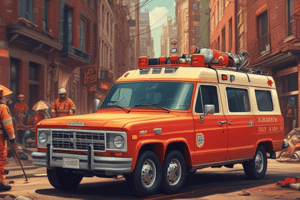Podcast
Questions and Answers
Under what circumstances can a vehicle approach a lowered railroad crossing gate?
Under what circumstances can a vehicle approach a lowered railroad crossing gate?
- If there is no visible train in the area
- Only during an emergency
- When railroad personnel confirm a malfunction (correct)
- When the driver feels it is safe
What should a driver do before crossing any railroad tracks?
What should a driver do before crossing any railroad tracks?
- Accelerate to cross quickly
- Use caution and ensure it is safe to proceed (correct)
- Stop only if a train is visible
- Call for help if unsure
In what conditions should a vehicle's retarder or Jake brake be turned off?
In what conditions should a vehicle's retarder or Jake brake be turned off?
- When driving under normal conditions
- In wet, snow, or ice covered roads (correct)
- When driving uphill
- When approaching an intersection
What is the policy on cell phone use while driving department vehicles?
What is the policy on cell phone use while driving department vehicles?
What must be done before backing a vehicle when a spotter is not available?
What must be done before backing a vehicle when a spotter is not available?
Which statement is true regarding the use of wheel chocks?
Which statement is true regarding the use of wheel chocks?
What is required when backing up all District apparatus?
What is required when backing up all District apparatus?
Which of the following is prohibited inside department apparatus or vehicles?
Which of the following is prohibited inside department apparatus or vehicles?
What is the maximum speed limit an emergency vehicle can exceed while responding under favorable conditions?
What is the maximum speed limit an emergency vehicle can exceed while responding under favorable conditions?
Which factor is NOT considered favorable for exceeding the posted speed limit during an emergency response?
Which factor is NOT considered favorable for exceeding the posted speed limit during an emergency response?
What must the officer ensure before the emergency vehicle starts moving?
What must the officer ensure before the emergency vehicle starts moving?
What does the use of sirens and warning lights by an emergency vehicle indicate?
What does the use of sirens and warning lights by an emergency vehicle indicate?
Which action should the officer take if the driver exhibits unsafe driving behavior?
Which action should the officer take if the driver exhibits unsafe driving behavior?
What is the officer required to do regarding the map book or MDT while en route to an emergency?
What is the officer required to do regarding the map book or MDT while en route to an emergency?
How should the driver of an emergency vehicle react to the actions of other drivers?
How should the driver of an emergency vehicle react to the actions of other drivers?
Which of the following is NOT a responsibility of the officer in the vehicle?
Which of the following is NOT a responsibility of the officer in the vehicle?
What is the correct procedure for positioning traffic cones on single lane roadways?
What is the correct procedure for positioning traffic cones on single lane roadways?
What should remain unblocked while crew members divert traffic?
What should remain unblocked while crew members divert traffic?
What is the minimum number of cones required to start a cone taper pattern on multi-lane roadways?
What is the minimum number of cones required to start a cone taper pattern on multi-lane roadways?
What is a critical safety guideline when removing cones in traffic?
What is a critical safety guideline when removing cones in traffic?
Which of the following describes the characteristics of channelizing devices?
Which of the following describes the characteristics of channelizing devices?
What procedure should be followed once traffic has stopped during an incident?
What procedure should be followed once traffic has stopped during an incident?
What is the recommended distance to place the first traffic cone from the rear of the apparatus bumper?
What is the recommended distance to place the first traffic cone from the rear of the apparatus bumper?
What should the crew do to maintain safety while working on the roadway?
What should the crew do to maintain safety while working on the roadway?
What type of safety vest is required for personnel working near roadways during traffic incidents?
What type of safety vest is required for personnel working near roadways during traffic incidents?
When should high-visibility safety vests be worn by personnel?
When should high-visibility safety vests be worn by personnel?
What is the minimum height requirement for safety cones used in roadway incidents?
What is the minimum height requirement for safety cones used in roadway incidents?
What is the required size for warning signs used on high-speed highways?
What is the required size for warning signs used on high-speed highways?
Under which conditions should a warning sign be placed for traffic incidents?
Under which conditions should a warning sign be placed for traffic incidents?
What additional safety measure can enhance safety during nighttime operations for traffic incidents?
What additional safety measure can enhance safety during nighttime operations for traffic incidents?
What is the recommended placement height for retro reflective tape on safety cones?
What is the recommended placement height for retro reflective tape on safety cones?
What should personnel do when they believe increased visibility would improve safety?
What should personnel do when they believe increased visibility would improve safety?
What should emergency personnel do when responding to an emergency call?
What should emergency personnel do when responding to an emergency call?
What is the responsibility of emergency vehicle operators while en route to an emergency?
What is the responsibility of emergency vehicle operators while en route to an emergency?
How should emergency vehicle operators approach intersections?
How should emergency vehicle operators approach intersections?
What should not be done by personnel not authorized to use emergency lights and sirens?
What should not be done by personnel not authorized to use emergency lights and sirens?
What must emergency vehicle operators do at intersections if traffic cannot be accounted for?
What must emergency vehicle operators do at intersections if traffic cannot be accounted for?
When multiple emergency vehicles respond together, vehicle operators should be cautious because:
When multiple emergency vehicles respond together, vehicle operators should be cautious because:
What action should a Lieutenant take if they believe an emergency response is warranted?
What action should a Lieutenant take if they believe an emergency response is warranted?
What happens if emergency vehicle operators do not drive with due regard for safety?
What happens if emergency vehicle operators do not drive with due regard for safety?
What should emergency vehicle operators do when responding to an emergency call?
What should emergency vehicle operators do when responding to an emergency call?
What is required at intersections where traffic cannot be accounted for?
What is required at intersections where traffic cannot be accounted for?
How should emergency personnel respond to multiple emergency vehicles present?
How should emergency personnel respond to multiple emergency vehicles present?
Which statement is true regarding the use of emergency lights and siren?
Which statement is true regarding the use of emergency lights and siren?
What should a Lieutenant do if they believe an emergency response is necessary?
What should a Lieutenant do if they believe an emergency response is necessary?
What action is NOT required from personnel not authorized to use emergency lights and siren?
What action is NOT required from personnel not authorized to use emergency lights and siren?
What should emergency vehicle operators do at street intersections?
What should emergency vehicle operators do at street intersections?
When should emergency vehicle operators begin to use emergency lights and siren?
When should emergency vehicle operators begin to use emergency lights and siren?
Flashcards are hidden until you start studying
Study Notes
Emergency Response
- Fire personnel dispatched to an emergency shall proceed immediately, shall continuously operate emergency lighting equipment and shall sound the siren as reasonably necessary.
- Responding with emergency lights and siren does not relieve personnel of the duty to continue to drive with due regard for the safety of all persons, or protect the driver from the consequences of his/her reckless disregard for the safety of others.
- Personnel should only respond with emergency lights and siren when dispatched to an emergency or when circumstances reasonably indicate an emergency response is required.
- Personnel not authorized to respond with emergency lights and siren shall observe all traffic laws and proceed without the use of emergency lights and siren.
- When more than one apparatus responds to an emergency, emergency vehicle operators should remain alert to the presence of other emergency vehicles and exercise due caution.
- Personnel must further exercise due caution in recognizing that traffic yielding to one emergency vehicle may not expect other emergency vehicles to follow.
- If a Lieutenant believes an emergency response to any call is appropriate, the Lieutenant shall ensure Dispatch is immediately notified.
Responsibilities of Responding Personnel
- Authorized emergency vehicle operators shall exercise sound judgment and care, with due regard for life and property, while operating a vehicle en route to an emergency response.
- In addition, emergency vehicle operators should reduce speed at all street intersections and should come to a complete stop at all blind street intersections or intersections where there is either a red light, a flashing red light or a stop sign.
- Emergency vehicle operators should also come to a complete stop at intersections whenever they reasonably believe they cannot account for traffic in approaching lanes or when vehicles have not yielded the right-of-way.
- After coming to a complete stop, emergency vehicle operators should only proceed when it is safe to do so.
- Officer shall ensure that all personnel on the vehicle are seated and secured with seat belts and in approved riding positions prior to movement of the emergency vehicle.
- Officer shall ensure driver is operating the vehicle in a safe and prudent manner during response in accordance with departmental policy and state law.
- Officer shall issue warnings about road and physical hazards to the driver.
- Officer shall direct the driver to cease any unsafe driving, such as excess speed or unsafe intersection practices.
- Officer shall, when practical, operate the radio, audio and visual warning devices during response.
- Officer shall check the map book or MDT to assist the driver in determining the safest and most direct route to the emergency scene.
Warning Lights
- When responding “Emergency”, warning lights and headlights shall be used and the siren shall be sounded to warn drivers of other vehicles, as required by the Illinois Vehicle Code.
- The use of sirens and warning lights does not automatically give the right-of-way to the emergency vehicle.
- These devices simply request the right-of-way from other drivers, based on their awareness of the emergency vehicles presence.
- Drivers must make every possible effort to make their presence and intended actions known to other drivers.
- They must drive defensively and be prepared for the unexpected actions of others.
Speed Limit
- In accordance with the Illinois Vehicle Code, emergency vehicles are authorized to exceed posted speed limits when responding “Emergency” under favorable conditions.
- This applies only with light traffic, good roads, good visibility, dry pavement, and no road construction.
- The maximum speed limit shall not exceed 10 mph over the posted speed limit.
- Under less than favorable conditions, the posted speed limit is the absolute maximum permissible.
Railroad Crossings
- Drivers shall use caution and ensure that it is safe to proceed prior to crossing any railroad tracks.
- Apparatus shall not drive around crossing gates that have been lowered, or proceed through a crossing with activated signals (non-#gated).
- The only exceptions shall be:
- When it has been confirmed by railroad personnel that the gates or signal are activated due to a malfunction or maintenance.
- When there appears to be an obvious malfunction and the company officer has left the vehicle and has visually confirmed the absence of any approaching trains in either direction.
Vehicle Retarders and Jake Brakes
- Vehicles and apparatus equipped with engine, transmission or driveline retarders or Jake brakes shall operate with the retarder in the “on” or “high” position.
- Due to the slippery nature of wet, snow or ice covered roads, the retarder or brake is to be placed in the “off” position when encountering these conditions.
Cell Phone Use
- Cell phones, personal or district, are prohibited from being answered while driving with the exception of Staff Officers.
Smoking
- Smoking is prohibited inside any department apparatus or vehicle.
Vehicle Backing
- Employees shall reference NLFD SOG 2.1 Backing Apparatus for the complete expectations of the Fire District.
- All District apparatus require the use of a spotter while backing up.
- Vehicles should only be backed if they do not have the option of driving forward.
- When a spotter is not available and a vehicle must be backed up the driver must a complete 360 walk around and identify any potential hazards.
- When available, two spotters should be utilized on both the driver and officer’s side of the vehicle.
- If the driver loses sight of the spotter he should stop immediately.
- Staff cars do not require the use of a spotter.
Wheel Chocks
- All vehicles that do not have a parking gear are required to use a wheel chock while not in the station.
- Wheel chocks will be placed on downhill side of the tire.
Traffic Incident Management
- When removing cones always face traffic (NEVER TURN YOUR BACK ON TRAFFIC)
- Channelizing devices should be constructed and ballasted to perform in a predictable manner when inadvertently struck by a vehicle.
- Channelizing devices should be crashworthy.
- Fragments or other debris from the device or the ballast should not pose a significant hazard to road users or workers.
- All devices should be MUTCD compliant.
- Single Lane Roadways
- Crews will place traffic cones in a straight and single line across both directions of traffic.
- At no time will crews set up a taper in either direction of travel because you will merge traffic, head-on, in both directions.
- Once traffic has stopped, crew members equipped with a stop/slow paddles, will divert traffic one direction at a time.
- If necessary, consider using a portable radio, on a fireground channel, to assist and/or coordinate traffic.
- Multi-lane Roadways
- While operating on a multi-lane roadway, crews will set up a cone taper pattern to direct traffic away from the activity area.
- A proper taper will start with a minimum of 6 traffic cones and may be extended if needed.
- Cone Taper Placement
- The first traffic cone shall be placed off the rear of the apparatus bumper, slightly over the white line.
- Crews then will take 10 steps (approx. 30’) upstream and one step inwards (away from traffic) then place the next cone.
- This will be repeated, as illustrated, in the diagram in this SOG.
- At no time shall a crew member stand at the rear of the blocking apparatus with a stop/slow paddle.
- Instead, crew members will stand in the front of the blocking apparatus with the stop/slow paddle.
- Safety
- Always maintain safety by facing the oncoming traffic and staying in safe protected zones.
- All members shall work within the protected incident workspace at all times.
- Personal Protective Equipment
- Proper Personal Protective Equipment / Clothing is required for all traffic incidents as outlined in Lexipol policy 914 on Personal Protective Equipment.
- Class II Vests
- All personnel shall wear class II high-visibility safety vests in addition to required personal protective equipment (PPE) whenever the emergency scene is located on or near a roadway where firefighters are subject to the hazards of moving traffic, construction vehicles or disaster recovery equipment as outlined in Lexipol policy 904 on High Visibility Safety Vests.
- Members who are working on roadways and are not directly exposed to fire, flame, excessive heat or hazardous materials are expected to wear a high-visibility vest.
- This includes pump operators, support personnel and command officers.
- When it is anticipated that the emergency scene will be located on a roadway, high-visibility safety vests should be donned along with other appropriate PPE at the time of dispatch.
- High-visibility vests should also be worn any time a member or a supervisor believes increased visibility would improve safety or efficiency.
- Warning Devices
- Safety Cones – All safety cones will be at least 18 inches high and have 6-inch retro reflective tape approximately 3-4” from the top of the cone.
- Safety Cones shall be deployed on all roadway incidents that require more than 5 minutes on scene.
- Warning Sign – Minimum sign size for high-speed highway use is 48” x 48” and shall be retro reflective with black lettering.
- The NLFD shall require the 48” x 48” sign on all traffic incidents that are in progress longer than 30 minutes and/or the traffic incident is in a location of poor visibility such as around a bend or up-hill.
- The sign shall be placed in the Advanced Warning Area and will be used in conjunction with the safety cones.
- Flares – Placing flares for night time operations greatly enhances scene safety.
- Be cautious on where flares are placed on the incident scene
Studying That Suits You
Use AI to generate personalized quizzes and flashcards to suit your learning preferences.





